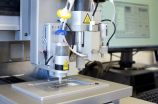(Press-News.org) Nyon, Switzerland - June 17, 2015 -- An International Osteoporosis Foundation (IOF) Working Group on Skeletal Rare Diseases has published a new classification of rare genetic metabolic bone disorders (RGMBDs) according to their metabolic pathogenesis.
Skeletal Rare Diseases such as osteogenesis imperfecta, juvenile Paget's disease or osteopetrosis, are only three of the more than 400 developmental abnormalities of the skeletal system that affect patients worldwide. Although rare, these 'orphan' diseases have a very serious, and often devastating, impact on the lives of the individuals affected.
Prof. Maria Luisa Brandi MD, Professor of Endocrinology and Metabolic Diseases at the University of Florence, Italy, lead author and Chair of the IOF Working Group on Skeletal Rare Diseases stated, "Due to the rarity of these diseases diagnosis is a challenge, and most patients - who are often children - currently have few choices when it comes to therapy. To date, the diagnosis of rare skeletal diseases is based primarily on clinical phenotype and radiographic analysis. We believe that knowledge of the metabolic pathway that characterizes these diseases provides important information that will help doctors select the most appropriate pharmacological treatment in patients affected by these complex diseases."
The taxonomy comprises 116 OMIM phenotypes, with 86 affected genes related to bone and mineral homeostasis. It divides the diseases into four major groups by listing the disorders due to:
altered osteoclast, osteoblast or osteocyte activity;
altered bone matrix proteins;
altered bone micro-environmental regulators;
deranged calciotropic hormonal activity.
The classification is a basis for the creation of an international registry of rare skeletal diseases. It also provides valuable information that may assist researchers in the development of genetic tests based on next generation sequencing, and in the initiation of large intervention trials to assess the efficacy of orphan drugs.
Prof. Cyrus Cooper, Chair of the IOF Committee of Scientific Advisors added, "Genetic disorders of the skeletal system represent a significant number of the world's recognized rare diseases. For affected individuals, these complex conditions are most often severe, degenerative, and chronically debilitating. Unfortunately, due to the rarity of these disorders, patients are currently faced with limited therapeutic options. We hope that knowledge derived from this new taxonomy will comprise an important first step in facilitating international cooperation of research, ultimately leading to new avenues for diagnosis and therapeutic intervention."
INFORMATION:
Taxonomy of rare genetic metabolic bone disorders
L. Masi, D. Agnusdei, J. Bilezikian, D. Chappard, R. Chapurlat, L. Cianferotti, J.-P. Devolgelaer, A. El Maghraoui, S. Ferrari, K. Javaid, J.-M. Kaufman, U. A. Liberman, G. Lyritis, P. Miller, N. Napoli, E. Roldan, S. Papapoulos, N. B. Watts, M. L. Brandi.
Osteoporos Int DOI 10.1007/s00198-015-3188-9
http://link.springer.com/article/10.1007/s00198-015-3188-9
(free access until August 16, 2015)
About IOF
The International Osteoporosis Foundation (IOF) is the world's largest nongovernmental organization dedicated to the prevention, diagnosis and treatment of osteoporosis and related musculoskeletal diseases. IOF members, including committees of scientific researchers, leading companies, as well as more than 200 patient, medical and research societies, work together to make bone, joint and muscle health a worldwide heath care priority. http://www.iofbonehealth.org; http://www.facebook.com/iofbonehealth; http://twitter.com/iofbonehealth
Scientists at the Ruhr-Universität Bochum established a mouse model for the human disease SCA6. SCA6 is characterised by movement deficits and caused by similar genetic alterations as Chorea Huntington. The mouse model will be used to investigate the disease mechanisms. Experiments suggest that an impairment of eye blink conditioning could be an early disease symptom. The team from the Department of Zoology and Neurobiology published their data in the Journal of Neuroscience; the work was highlighted by the editor's commentary.
Spinocerebellar ataxia 6: structural ...
This news release is available in German. Ragweed (Ambrosia artemisiifolia) - an otherwise unremarkable plant - produces pollen that can trigger strong allergic reactions such as asthma even in very small quantities. Scientists from Technische Universität München (TUM) and Helmholtz Zentrum München have now published a joint study showing that the substance previously identified as the major allergen only induces such a vigorous allergic response in combination with the adenosine also present in the pollen.
Ragweed only started to become widespread ...
A group of researchers at Chalmers University of Technology have managed to print and dry three-dimensional objects made entirely by cellulose for the first time with the help of a 3D-bioprinter. They also added carbon nanotubes to create electrically conductive material. The effect is that cellulose and other raw material based on wood will be able to compete with fossil-based plastics and metals in the on-going additive manufacturing revolution, which started with the introduction of the 3D-printer.
3D printing is a form of additive manufacturing that is predicted to ...
Astronomers have long theorised the existence of a first generation of stars -- known as Population III stars -- that were born out of the primordial material from the Big Bang [1]. All the heavier chemical elements -- such as oxygen, nitrogen, carbon and iron, which are essential to life -- were forged in the bellies of stars. This meansthat the first stars must have formed out of the only elements to exist prior to stars: hydrogen, helium and trace amounts of lithium.
These Population III stars would have been enormous -- several hundred or even a thousand times more ...
Scientists have developed a new tissue 'scaffold' technology that could one day enable the engineering of large organs.
Research led by the Universities of Bristol and Liverpool has shown that it is possible to combine cells with a special scaffold to produce living tissue in the laboratory. It is hoped this can then be implanted into patients as a way of replacing diseased parts of the body.
Until now, the approach has generally been limited to growing small pieces of tissue, as larger dimensions reduce the oxygen supply to the cells in the centre.
A team of ...
HOUSTON, June 18 -- Taking research from the lab to the clinic can be a long and arduous process, but necessary to ensure new therapeutic methods are safe. This typically involves models created in the lab to closely resemble the cellular mechanism of the human body.
Researchers at Baylor College of Medicine say they have now created a new disease model that more than just resembles the human mechanisms; it acts as a fully functioning human lipid system within a mouse to specifically study hypercholesterolemia, a form of high cholesterol caused by a genetic defect.
The ...
About a fifth of all U.S. children live in poverty. These children are more likely to experience learning and cognitive delays. Researchers have tried to determine causes for this disparity, with recent work identifying the hormone cortisol as a possible reason because of its ability to pass the blood-brain barrier. Cortisol is one of the most influential hormones in the human body, often referred to as the stress hormone because it's secreted into the bloodstream at higher levels as part of the body's flight-or-fight response. Now a new study has identified how specific ...
Teenagers vary substantially in their ability to control impulses and regulate their behavior. Adolescents who have difficulty with impulse control may be more prone to risky sexual behavior, with serious consequences such as sexually transmitted diseases and unintended pregnancies. A new study has found that individual differences in working memory can predict both early sexual activity and unprotected sexual involvement during adolescence.
Working memory -- the system in the brain that allows individuals to draw on and use information to plan and make decisions -- ...
Migraine researchers and clinicians are growing excited about a new class of drugs called Calcitonin Gene-Related Peptide (CGRP) monoclonal antibodies, which are showing promise in treating high-frequency episodic migraine and chronic migraine.
"This development is a transformative moment in migraine treatment," said Peter J. Goadsby, MD, PhD, who is chair of the scientific program of the American Headache Society's annual Scientific Meeting. Dr. Goadbsy is Chief of the UCSF Headache Center, and one of the world's leading headache treatment experts and researchers. ...
So perhaps there is some truth in the old legends of the underworld reeking of brimstone (or sulphur, as it is now called)? New research confirms that the Earth's core does in fact contain vast amounts of sulphur, estimated to be up to 8.5 x 1018 tonnes. This is about 10 times the amount of sulphur in the rest of the Earth, based on the most recent estimates (and for comparison, around 10% of the total mass of the Moon). This is the first time that scientists have conclusive geochemical evidence for sulphur in the Earth's core, lending weight to the theory that the Moon ...

